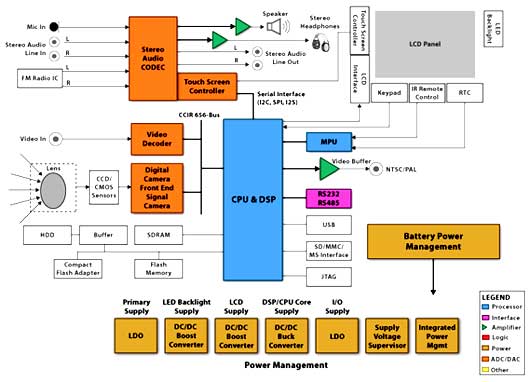TI手提多媒体设备解决方案
Portable Media Devices
Portable Media Device block diagram, design challenges and suggested devices.
Block Diagram

Design Considerations
The Portable Media Player is a handheld audio/video system that can record and playback audio/video (A/V) from TV, DVD player, camera, or media file downloaded from internet.
The Core Subsystems include:
• DSP/CPU
- The DSP performs digital A/V processing in all standard media formats. The CPU executes operating-system software and controls data tranfer and user interface.
• Digital Video Input
- comes from the analog video decoder or the CMOS/CCD camera. The analog video decoder converts the NTSC/PAL/S-Video analog input to raw digital video.
• Stereo Audio Codec
- converts the analog audio input from microphone, FM receiver, and and stereo audio line source into digital audio.
• CCIR656 Bus
- to input the raw digital video to the DSP.
• Serial Interface
- performs file transfer with the host computer via USB, RS232, and JTAG serial interfaces.
• Memory Interface
- handles a variety of direct memory interfaces with various portable memory media including compact flash card, SD card, MMC card, memory stick etc.
• IDE Interface
- handles data transfer with a hard drive storage.
• User Interface
- allows the user to control the PMP using the keypad, IR remote control, or the touch screen.
• Power Conversion
- converts input power (battery or wall plug) to run various functional blocks.
Application Notes
• Interfacing an LCD Controller to a DM642 Video Port (Rev. B) (spra975b.htm, 10 KB)
03 May 2004 Abstract
- 全面解读 嵌入式DSP上的视频编解码(08-19)
- 基于ADSP-TS201S的图像采集处理系统(08-12)
- 基于Blackfin533的H.264编码(08-18)
- 图形液晶显示模块在嵌入式系统中的应用(09-02)
- 基于DSP和FPGA的电视观瞄系统设计(09-02)
- DSP片外高速海置SDRAM存储系统设计(10-02)
